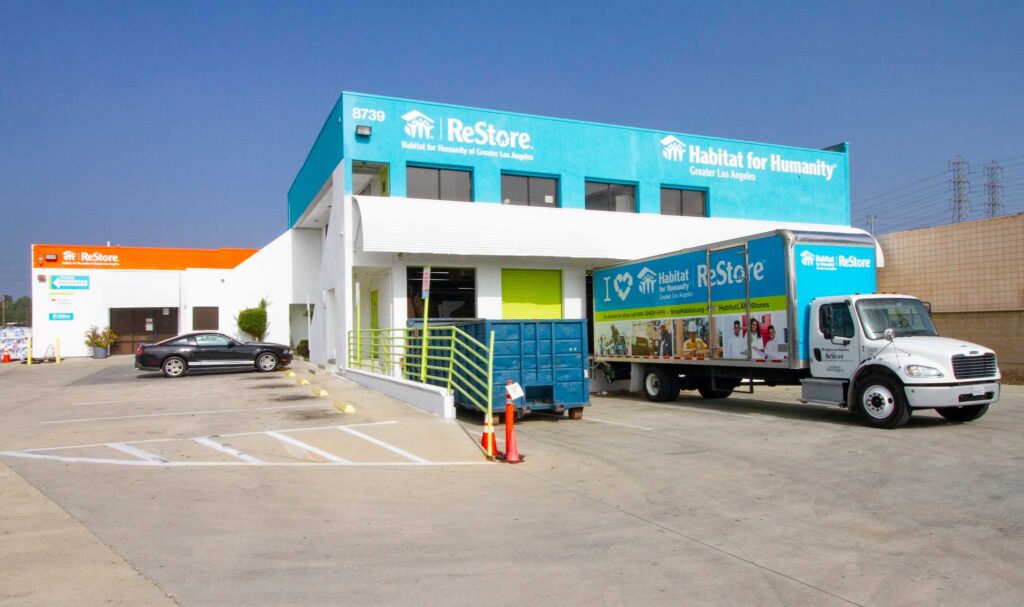All Your Questions About Habitat for Humanity ReStores, Answered
This site contains affiliate links to products. We may receive commission for purchases made through these links. Price at time of publish date may change.
Drew and Jonathan have partnered with Habitat for Humanity for over 25 years, working with the organization to help raise awareness and bring affordable housing to families all across the US, and even around the world. They volunteered with the Carter Work Project, have participated in countless builds, raised money to support new sites, and they were even named Habitat Humanitarians in 2017. The organization is a pillar, not just in their community, but in nearly every community. Habitat for Humanity is a global non-profit housing organization across all 50 states and in 70 countries, working to make affordable housing a reality for everyone. There are many ways Habitat for Humanity helps support individual communities, and one of them is through their ReStores. Independently owned and operated by local Habitat organizations, ReStores are resale stores that sell new and gently used furniture, appliances, building materials, and home goods at a fraction of their retail costs.
With National Thrift Day on August 17, we thought it’d be the perfect time to talk about ReStore and give you the inside scoop on what it’s all about. We spoke with Angy Smith, SVP of Retail Operations for Habitat for Humanity of Greater Los Angeles, and she gave us all the information you need on how to shop at your local ReStore, including tips for finding hidden gems; how to donate; and what Habitat ReStores are doing for your local community.
Tips for First-Time Shoppers
“If you are a first time shopper at a ReStore, it is recommended to plan some time to walk through the entire store and chat with the employees and volunteers to better understand what they get on a regular basis,” Angy says. For example, there might be rewards programs available depending on the store, and they’ll provide you with all the information you need to get started shopping and donating at that specific location.
“All ReStores are independently run by the local Habitat for Humanity affiliate,” she says. Check online for your local ReStore location hours, and follow them on social media to stay up-to-date on any events or sales. “The great thing about a ReStore is that they are getting donations from residential and commercial donors all year long, so there is no best time to shop a ReStore… Except every day, because they are getting new donations daily,” Angy says.
What Makes Habitat ReStores Different
“What sets ReStores apart is that all proceeds support Habitat for Humanity’s mission to build and improve homes for people in need,” Angy says. “Shopping or donating at a ReStore helps fund affordable housing projects in the local community.” But it doesn’t just end with shopping and donating—volunteering is also a fantastic way to get involved and make an impact.
Look up your nearest ReStore here, and explore the options they have available in your area. Some ReStores offer in-store volunteer opportunities for individuals and groups; others offer construction and repair volunteer days; and depending on your location, you might even be able to volunteer in the warehouse, office, or as a photographer on-site.
How to Donate to Your Local Habitat for Humanity ReStore
“If you are interested in donating to a ReStore, please check their website for the best way to get donations to the ReStore,” Angy says. “Some ReStores offer a pick-up service and some require you to drop off your donations. Each donor will receive a donation receipt for tax purposes.”
“The ReStores do not restore items that are broken or in bad condition, but can take an item that has been gently used and give it a new life in someone else’s care. So check your local ReStore’s website to ensure what you are donating meets their needs prior to donating,” she says.
What You Can and Cannot Donate to ReStores

“The items that are always in need are gently used furniture (especially sofas, tables and chairs); working appliances; cabinets and fixtures (properly deconstructed); lumber and building materials; lighting and hardware; and commercial donations from suppliers, retailers and third party delivery services,” she says.
However, there are some items that ReStores do not accept, so keep this in mind before bringing your items in. “Generally, ReStores do not accept mattresses or box springs (some exceptions exist); hazardous materials (paint, chemicals); broken or heavily damaged furniture; non-working appliances; items with mold, mildew, or strong odors,” she says. “Policies vary, so check your local ReStore’s ‘Do Not Accept’ list before donating.”
The Impact of Habitat for Humanity ReStores
“The proceeds from each ReStore go to further the mission of the affiliate they are a part of. This can include building homes, critical home repairs, as well as the job opportunities they provide for the employees that work in and support their ReStore,” Angy says. “More specifically, the ReStores also serve as a connection point for the affiliate in the community they serve and have hosted events, trainings and distribution events to support the mission of their affiliates.”
So, for National Thrift Shop Day, get involved in your local community to help make a difference. Be it by donating items, shopping at ReStore, volunteering once a month, or supporting your local Habitat for Humanity in another way, every action makes a difference. Together, we can all help make our communities better, stronger, and safer for everyone. It starts with you!
14 Quality Online Furniture Thrift Stores and How to Shop Them
Secondhand furniture shopping is finally made easy.
Read More